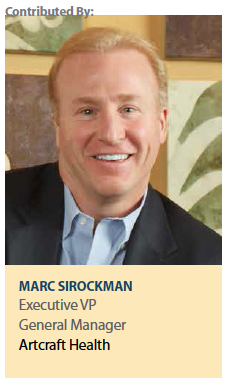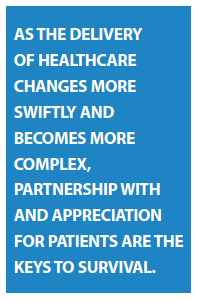 The healthcare industry has struggled with many changes in the last 10 years, including the inevitable patent cliff, the emergence of patient advocacy, increased regulatory and healthcare reform, and the rising cost of doing business. However, even in this age of rapid innovation and adaptability, most of us within our industry seem to be slow on the uptake. Rather than changing the way we allocate funds and execute strategies and solutions, many of us stick to antiquated methods that inevitably obstruct or delay our goals and objectives.
The healthcare industry has struggled with many changes in the last 10 years, including the inevitable patent cliff, the emergence of patient advocacy, increased regulatory and healthcare reform, and the rising cost of doing business. However, even in this age of rapid innovation and adaptability, most of us within our industry seem to be slow on the uptake. Rather than changing the way we allocate funds and execute strategies and solutions, many of us stick to antiquated methods that inevitably obstruct or delay our goals and objectives.
The traditional modus operandi of delivering a healthcare product or service must be transformed into an integrated system that ultimately facilitates wellness and better outcomes. It is critical to understand that the needs of patients are the starting point for initiatives concerning them.
Strategize Your Challenges
Since 2005, the number of registered clinical trials has increased globally from 24,934 to 182,951 — an 86% increase over the last 10 years. However, it was only since 2011 that patient-centered outcomes research became a term widely used in the industry. Before 2011, the priorities of research were focused predominantly on the physicians and the payers.
Let’s take a quick look at the current landscape of R&D:
The average cost per patient in a late-phase clinical trial is approaching $26,000
The average site startup cost is $15,000 to $20,000 per site
According to recent studies, the average length of time from the clinical testing to market is 90.3 months, or about 7.5 years
Only 20% of clinical trials meet their enrollment objectives
One third of Phase 3 study terminations are due to difficult recruitment and enrollment
Every day that a blockbuster drug is delayed, more than $2.7 million in revenue is lost or deferred
The estimated cost of bringing a new drug to market is now between $161 million and $2 billion
The current clinical trial landscape is saturated with clinical trials, each vying for a first-to-market designation, with many more ready to take their place when recruitment fails or the verifiable data are not obtained.
The good news, however, is that by focusing on patients from the beginning, and partnering with them for mutual benefit, these challenges can be overcome.
Innovative Partnership
 The pace of innovation in healthcare has rendered our traditional approaches to clinical trials inadequate. Any visitor to ClinicalTrials.gov, whether a patient or healthcare provider, will tell you that the volume of information, including the medical terms and vocabulary, data, and details, is overwhelming. The vast scope of this information and of the user experience itself is something I would expect from a government website, but is this really the first introduction you would want for your loved one or expect for yourself? The answer should be and is no.
The pace of innovation in healthcare has rendered our traditional approaches to clinical trials inadequate. Any visitor to ClinicalTrials.gov, whether a patient or healthcare provider, will tell you that the volume of information, including the medical terms and vocabulary, data, and details, is overwhelming. The vast scope of this information and of the user experience itself is something I would expect from a government website, but is this really the first introduction you would want for your loved one or expect for yourself? The answer should be and is no.
The best way to partner with patients is to simplify and minimize the burden of their partnership. Based on our experience, it takes a greater understanding of the patient perspective to make clinical trial awareness, recruitment and enrollment strategies a success.
Not all innovative solutions are created equal. It’s not just about the solutions; you need to optimize the strategy through clear, actionable, and engaging design and content. There should be an empathetic portrayal of the patient’s story, and have it resonate to their individual challenges, concerns, and questions. Leverage technology as the conduit to ascertain the needed information, and then communicate true meaning of the partnership you want to establish with patients.
We have used innovation as a way to communicate and provide access to the right patient, with the right message at the right time. Through social listening and digital media technologies, you can attain a greater understanding of patients’ perceptions and needs. Build trust not by directing them to ClinicalTrials.gov but by providing them with an easy-to-navigate and understandable digital hub where they can be educated about a trial, learn about eligibility requirements, and follow the steps to enrollment. Technologies such as tablets and smartphones give you the ability to better engage with and educate patients about trials.
As the delivery of healthcare changes more swiftly and becomes more complex, partnership with and appreciation for patients are the keys to survival. By developing clinical marketing strategies that focus on patients, deliver a compelling story and leverage innovation you will be able to meet your objectives while providing potentially lifesaving treatments.(PV)
Artcraft Health is an award-winning, full-service health education agency specializing in the creation and development of compelling solutions that are aligned with our clients’ strategic imperatives. We work with our clients to develop strategies and tactics to overcome health literacy barriers and promote effective, innovative outcomes across the healthcare continuum.
For more information, visit artcrafthealth.com.










